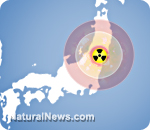
Most Viewed Articles
Today
Week
Month
Year
- Newly released JFK files reveal Pentagon's role in creating Lyme disease and covid in the same lab
- Trump nominates VACCINE ZEALOT Susan Monarez to lead the CDC, sidelining RFK Jr.'s reform efforts
- BEWARE: USDA allows genetically engineered vaccines to infiltrate organic food production
- Obama accused of laundering USAID funds to fuel global protest movements, regime change operations
- Festive flavors: The sweet history, nutritional profile and health benefits of pecan pie
- Dr. Mike Yeadon releases 15-minute testimony - WATCH - about genocidal intent of COVID “vaccines”
- Analysis: The coming economic collapse, a mass uprising and Trump's three secret weapons to halt the growing revolt
- Big Pharma's media takeover: How drug companies bought the news - and your health
- Elon Musk: Aliens could be here on Earth RIGHT NOW
- Trump reverses course on Gaza plan, says “nobody is expelling Palestinians”
- Survival 101: Effective EMF blocking techniques
- California's social media censorship law struck down: A victory for free speech or a threat to online safety?
- Reclaim your health: How midlife exercise reverses years of inactivity
- Rep. Nancy Mace introduces bill to ban biological males from female facilities on federal property
- Big Pharma's $8 Billion bribery scheme exposed: how doctors are pushed to prescribe junk science, not heal
- HUGE: Putin claims 2020 election fraud in U.S. sparked Ukraine war, calls for peace talks with Trump
- Chris Rufo finally reveals abuse liberals unleashed on his wife and young kids...
- RFK Jr.'s SSRI antidepressant investigation sparks liberal meltdown, exposes Big Pharma's dangerous game
- Elon Musk: Aliens could be here on Earth RIGHT NOW
- EPA advisor admits the agency is funneling billions to climate groups ahead of Trump’s return to White House
- Trump reverses course on Gaza plan, says “nobody is expelling Palestinians”
- Reclaim your health: How midlife exercise reverses years of inactivity
- A lack of integrity in Academia: Harvard professor found GUILTY of fraudulent research to promote CRT theory
- Space war brewing? Russia threatens to destroy Starlink satellites
- Big Pharma's $8 Billion bribery scheme exposed: how doctors are pushed to prescribe junk science, not heal
- Mike Adams Sermon 66: God will DESTROY ISRAEL for its wickedness
- Rep. Nancy Mace introduces bill to ban biological males from female facilities on federal property
- Survival 101: Effective EMF blocking techniques
- 5 Simple steps to boost your brainpower: How to strengthen executive function in a distracted world
- Historian warns Israel may be entering an “IRREMEDIABLE DECLINE”
- Florida takes a stand: DeSantis proposes permanent ban on mRNA vaccine mandates
- RFK Jr.'s SSRI antidepressant investigation sparks liberal meltdown, exposes Big Pharma's dangerous game
- New York politicians push bill allowing governor to indefinitely detain the unvaccinated on a whim
- Sales of survival bunkers rise following Russia’s use of the Oreshnik hypersonic ballistic missile
- Pilots report mysterious lights 'moving at extreme speeds' across Oregon skies
- Newly released JFK files reveal Pentagon's role in creating Lyme disease and covid in the same lab
- EPA advisor admits the agency is funneling billions to climate groups ahead of Trump’s return to White House
- The Health Ranger releases “Vaccine Zombie” song and music video, using AI-animated zombies for the music video
- The pandemic as a tool for INDOCTRINATION: Understanding “The Indoctrinated Brain” by Dr. Michael Nehls
- California's social media censorship law struck down: A victory for free speech or a threat to online safety?
- Dr. Mike Yeadon releases 15-minute testimony - WATCH - about genocidal intent of COVID “vaccines”
- Congratulations to the FULLY UNVACCINATED as you resisted the COVID-19 PROPAGANDA MACHINE fueled by over $100 BILLION
- Mike Adams releases country western hit single: Goin’ Back in Time is Comin’ Home
- RFK Jr. clears key hurdle: Sen. Susan Collins backs controversial HHS nominee, signaling a new era for health policy
- Mike Adams releases music poetry sensation: A Child of God
- Mike Adams releases new song and music video: Nothing More Disgusting Than a Globalist
- Unpacking the Lies That We’ve Been Fed – new song and music video released by Mike Adams, the Health Ranger
- Trump administration takes on global censorship: A new frontier for free speech advocacy
- Florida takes a stand: DeSantis proposes permanent ban on mRNA vaccine mandates
- “Why we influenced the 2020 elections”: Facebook files reveal the coordinated effort to bury the Hunter Biden laptop story
- Ex-FBI Chief EXPOSES disgraceful government coverups of Oklahoma City Bombing, Kennedy assassinations, 9/11 WTC, and "Terrorism" as plot to destroy Constitution
- Michigan sheriff announces criminal investigation into 2020 election crimes, Dominion Voting Systems
- Israeli soldiers accused of even more torture and abuse in the West Bank
- Federal judge backs Trump's mass firings, clearing path for government downsizing
- Red Cross issues warning to stop blood plasma donations from vaccinated people
- Scientists confirm: GENIUS brain function can be spontaneously unleashed in humans without any apparent cause
- EPA advisor admits the agency is funneling billions to climate groups ahead of Trump’s return to White House
- HYSSOP: What research reveals about the health benefits of this ancient holy herb
- Two containers with completed ballots fall out of truck in Florida
- Fully vaccinated about to see “tsunami” of illness and death, warns virologist
- Today I asked our AI language model “Neo” about which phytonutrients or phytochemicals can block the spike protein related to SARS-CoV-2 … Here is what it answered…
- Global leaders unite to clamp down on “misinformation” with UN-backed Cascais Declaration
- BREAKING: 2025 NDAA authorizes mandatory military draft of WOMEN across America… as Pentagon pursues global NUCLEAR war with both Russia and China at the same time
- Michael Yon warns of a ZIONIST TAKEOVER in Trump’s second administration
- BOMBSHELL: DNA testing kits are a SCAM to develop ethnic-specific bioweapons
- Ozempic and Wegovy weight loss drugs are injectable LIZARD VENOM PEPTIDES that may unleash a devastating wave of organ failure… side effects align with symptoms of SNAKE BITES
- Israeli soldiers accused of even more torture and abuse in the West Bank
- These 13 countries just signed an agreement to engineer a global FAMINE by destroying food supply
- NASA admits that climate change occurs because of changes in Earth’s solar orbit, and NOT because of SUVs and fossil fuels
- RFK Jr. clears key hurdle: Sen. Susan Collins backs controversial HHS nominee, signaling a new era for health policy
- Sermon 30: How Jesus reveals Caesar’s FAKE CURRENCY and FALSE AUTHORITY
- Coriander seeds: Ancient medicine backed by modern science
(NaturalNews) - Measurements taken recently at the tsunami-damaged Fukushima nuclear complex in northern Japan have revealed record levels of radiation contamination, officials with the plant's operator, Tokyo Electric Power Company, said.
The elevated contamination levels were discovered in the basement of reactor No. 1, officials said - a discovery that will further delay and impede operations aimed at cleaning up the site. It was the first internal measurement carried out since three of the plant's nuclear reactors were damaged by a tsunami caused by a major earthquake off Japan's northeastern coast in March 2011.
TEPCO engineers reportedly gathered samples from the basement after inserting a camera and consulting measuring instruments through a drain hole located in the ceiling of the basement.
The company said radiation levels above radiation-contaminated water in the basement measured as high as 10,300 millisievert per hour - a dose plenty high enough to kill human beings in short order after making them sick within minutes.
Radiation levels even higher than anticipated
Put another way, the annual allowable dose for plant workers at the site is reached in just 20 seconds. One report said the dose was enough to kill humans in less than an hour.
"Workers cannot enter the site and we must use robots for the demolition," said TEPCO, in a statement.
TEPCO official, Junichi Matsumoto said he believed there was a higher radiation level in the No. 1 reactor because more fuel rods than suspected melted down following the incident.
The power company said radiation levels there were 10 times what they have measured at the plant's other damaged reactors, numbers two and three. In all, the Fukushima plant contained six reactors.
The meltdown of the reactors came after the tsunami managed to cut power to their cooling systems.
The plan now is to demolish the three damaged reactors, as well as the plant's No. 4 unit, but that is expected to take 40 years and will require use of new technologies.
New danger - the weather
Meanwhile, Fukushima now faces yet another impending typhoon season, which could result in even more damage and contamination at the site.
Already this season Typhoon Guchol has hit Japan, which led to warnings of floods and landslides from the Japan Meteorological Agency.
Typhoons are common to Japan this time of year so that part is nothing new. But given the exposure and vulnerability of the Fukushima Daichai plant, the risk of a violent storm causing even more calamity is real.
A major tornado also struck in the latter part of June, killing a teenage boy, injuring 50 others and destroying houses and property.
Scientists are particularly worried about twisters hitting the damaged plant.
"Uranium spent fuel pools of No. 3 and No. 4 reactors are currently naked," Kazuhiko Kudo, a research professor of nuclear engineering at Kyushu University, said June 5. "A tornado with winds of 100 meters per second like the one that hit Tsukuba could suck up the pool water," exposing the fuel rods, he said.
Sources:
http://uk.news.yahoo.com
http://www.rttnews.com
http://fuelfix.com
The elevated contamination levels were discovered in the basement of reactor No. 1, officials said - a discovery that will further delay and impede operations aimed at cleaning up the site. It was the first internal measurement carried out since three of the plant's nuclear reactors were damaged by a tsunami caused by a major earthquake off Japan's northeastern coast in March 2011.
TEPCO engineers reportedly gathered samples from the basement after inserting a camera and consulting measuring instruments through a drain hole located in the ceiling of the basement.
The company said radiation levels above radiation-contaminated water in the basement measured as high as 10,300 millisievert per hour - a dose plenty high enough to kill human beings in short order after making them sick within minutes.
Radiation levels even higher than anticipated
Put another way, the annual allowable dose for plant workers at the site is reached in just 20 seconds. One report said the dose was enough to kill humans in less than an hour.
"Workers cannot enter the site and we must use robots for the demolition," said TEPCO, in a statement.
TEPCO official, Junichi Matsumoto said he believed there was a higher radiation level in the No. 1 reactor because more fuel rods than suspected melted down following the incident.
The power company said radiation levels there were 10 times what they have measured at the plant's other damaged reactors, numbers two and three. In all, the Fukushima plant contained six reactors.
The meltdown of the reactors came after the tsunami managed to cut power to their cooling systems.
The plan now is to demolish the three damaged reactors, as well as the plant's No. 4 unit, but that is expected to take 40 years and will require use of new technologies.
New danger - the weather
Meanwhile, Fukushima now faces yet another impending typhoon season, which could result in even more damage and contamination at the site.
Already this season Typhoon Guchol has hit Japan, which led to warnings of floods and landslides from the Japan Meteorological Agency.
Typhoons are common to Japan this time of year so that part is nothing new. But given the exposure and vulnerability of the Fukushima Daichai plant, the risk of a violent storm causing even more calamity is real.
A major tornado also struck in the latter part of June, killing a teenage boy, injuring 50 others and destroying houses and property.
Scientists are particularly worried about twisters hitting the damaged plant.
"Uranium spent fuel pools of No. 3 and No. 4 reactors are currently naked," Kazuhiko Kudo, a research professor of nuclear engineering at Kyushu University, said June 5. "A tornado with winds of 100 meters per second like the one that hit Tsukuba could suck up the pool water," exposing the fuel rods, he said.
Sources:
http://uk.news.yahoo.com
http://www.rttnews.com
http://fuelfix.com
Follow real-time breaking news headlines on
Fukushima at FETCH.news
Fukushima at FETCH.news
Receive Our Free Email Newsletter
Get independent news alerts on natural cures, food lab tests, cannabis medicine, science, robotics, drones, privacy and more.
Take Action: Support Natural News by linking to this article from your website
Permalink to this article:
Embed article link: (copy HTML code below):
Reprinting this article:
Non-commercial use OK, cite NaturalNews.com with clickable link.
Follow Natural News on Facebook, Twitter, Google Plus, and Pinterest
Natural News Wire (Sponsored Content)
Science.News
Science News & Studies
Science News & Studies
Medicine.News
Medicine News and Information
Medicine News and Information
Food.News
Food News & Studies
Food News & Studies
Health.News
Health News & Studies
Health News & Studies
Herbs.News
Herbs News & Information
Herbs News & Information
Pollution.News
Pollution News & Studies
Pollution News & Studies
Cancer.News
Cancer News & Studies
Cancer News & Studies
Climate.News
Climate News & Studies
Climate News & Studies
Survival.News
Survival News & Information
Survival News & Information
Gear.News
Gear News & Information
Gear News & Information
Glitch.News
News covering technology, stocks, hackers, and more
News covering technology, stocks, hackers, and more













































